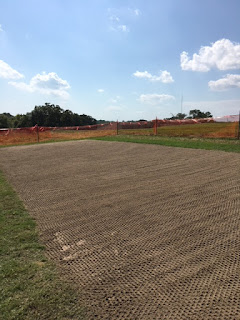October Brings Rain!
Hello all you loyal blog followers, and welcome to the official cool season!
October has finally brought our reliable and predictable cooler weather. What a relief it is. During the summer months, as we're hand watering for 6 hours a day, this weather is but a dream to us. Our greens and collars are cool season grass, meaning they strive once temperatures drop and moisture is more available. The first 10 days of October brought us 10+ inches of rain. Almost 8 inches alone fell on Sunday the 7th. With abundant moisture and temperatures riding around the 50-60's, our greens and green surrounds have started to fill in, grow up, and green up, all in time for the end of season.
On the opposite end of the spectrum, you'll notice the zoysia grass that makes up our fairways and tees has started to turn a straw yellow compared to its mid summer green. Zoysia grass is a warm season turf, so as soon as temperatures start to consistently be cool, it begins to go dormant for the winter. Dormancy is comparable to hibernation, the living part of the turf moves down the plant and into the ground insulated roots, hence the yellowing of the leaf. October 3rd was the final fairway cut of the season. Shaggy fairways aren't the best for playing conditions, but with that extra grass going into winter, the roots will have even more insulation to keep them healthy and ready to spring back in action when the warmer weather reappears.
As far as maintenance goes, nothing too exciting in October. Our rough is still being mowed, we are mowing and rolling greens every other day respectively, and still fixing those all too familiar irrigation leaks. We sprayed our rough for broad leaf weeds such as clover and dandelions. This weather is great for spraying because the plant takes the nutrients right to the roots to prepare for winter, as compared to summer when the plant absorbs nutrients into the leaf only. With the herbicide in the roots, we should see a better affect on the plant as a whole.
Our native grasses were knocked down following the first frost. In an earlier post, I mentioned that conservation of the Monarch Butterfly includes not cutting down native areas that contain Milkweed, the butterfly's main source of nutrition during migration, until after the first frost. The plant's seed containing pods pop open and allow seeds to disperse once the first frost has arrived. Waiting to cut natives allows butterfly's nutrition as well as the plant to spread and return next year.
Superintendent Sam Bailey doing an excellent job mowing the native between 18's tee complex and fairway (Left). Milkweed plants being cut down. (Above)
Looking forward we expect to see leaves dropping left and right as fall continues into winter. As beautiful as the leaves look as they change colors, the moment they hit the ground they become a whole new project and problem for us and the golfers.
Don't forget to fix your ball marks, pick up your clubs, and enjoy Swope Memorial Golf Course with a refreshing cold beverage!






